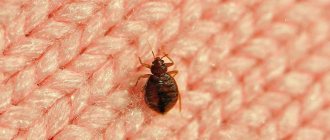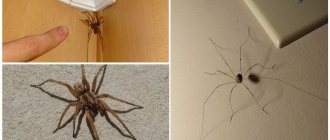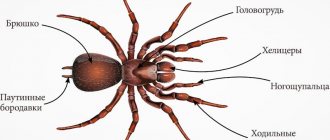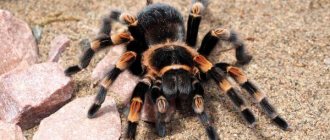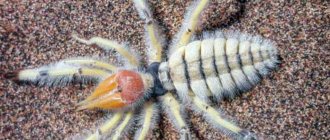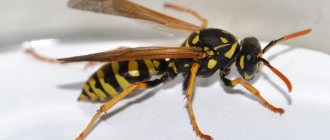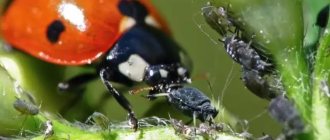Arachnids are considered one of the most widespread species on the planet. Today, scientists have described about 114 thousand representatives of the class, of which more than 40 thousand are spiders. The study revealed that it was spiders who were the first to come to land and become ground dwellers.
Today, the importance of spiders for nature and humans is being studied by specialists. Some species are very dangerous, but there are also those that are beneficial.
Description of arachnids
Spiders belong to the kingdom Animalia and the phylum Arthropods. Today, experts have established that they originated from crustaceans, this explains the structure and some other features.
Representatives
In nature there are a wide variety of species with different sizes and feeding habits.
But there are several representatives that are the most common:
- The tarantula is considered the largest representative of the class. Its leg span reaches 30 cm. These animals live in Africa, Australia and other countries with hot climates. There are several varieties of tarantulas, differing in size and body color. Many fans of exotics keep such arthropods at home.
- cross spiders in nature. The arthropod got its name due to the peculiar pattern on its body, reminiscent of a cross. It is small in size, with a convex, oval-shaped body. The color can be of different shades - from gray to red. In Russia, a variety of crosses has been recorded; there are about 30 species.
- Karakurt is common in Central Asia, Kazakhstan, and Africa. The female is called the “black widow” because of the uniform color of the body. Males have red spots on their bodies. The size of the largest representative does not exceed 20 mm. The species is considered dangerous to humans
- The camel spider looks like a scorpion and is 7 cm long. It is not poisonous, but the bite of the animal is very painful. The arthropod's chelicerae closely resemble the claws of a scorpion.
- Jumping spiders are quite common, there are about 6 thousand species. They live in tropical climates and are small in size. A unique feature of the arthropod is jumping over long distances.
- Argiope Brunnich is a common species, lives in Korea, Crimea, Southern Europe, and Russia. The arthropod is popularly called the wasp spider because of the special color of its body.
- Wolf spiders live almost everywhere except Antarctica. They have a small size, not exceeding 30 mm in leg span. Individuals are considered earth dwellers and live in burrows. A distinctive feature of arthropods of this species is that they weave webs only in a hole.
- Harvest spiders are a numerous species of spider, numbering about 1000 subspecies. The body of individuals is small, the legs are long. They are distributed everywhere, often live in human homes, and feed on insects.
- The runner, or wandering spider, is one of the most poisonous representatives of arthropods, lives mainly in Brazil, its size reaches 15 cm. The spider lives in burrows, feeds on frogs, lizards and small snakes.
There are many more varieties of spiders, distributed throughout the world, differing in size, color and feeding habits.
Brazilian soldier spider
Insects or not
Not everyone knows whether an insect is a spider or not. Outwardly, many individuals resemble insects, but many differences can be seen in their structure and feeding method.
Arthropods belong to the class Arachnida and the order Spiders, so they are not insects. The differences can be seen in the table.
What spiders live in houses?
House spiders love dry climates and warmth, so they can most often be found during the warm seasons of the year.
It’s quite normal for several species to coexist next to a person, so it’s worth thinking about how to get rid of spiders in an apartment . The most common ones include:
- The haymaker spider is also known by other names - the centipede or window spider. The body of this spider consists of a round or oval abdomen up to 1 cm in length and eight or six legs, which are the most noticeable part of the body, since their length often reaches 5 cm. The haymaker sets up special nets in the corners of his home for his prey. Various small insects, once trapped, begin to flutter and become even more entangled. While the spider guarding them injects poison with a paralyzing effect into the body of the victim and feeds on it, or leaves it for the future. In apartments, the haymaker likes to settle in dark corners and near windows, prefers to hang upside down. Seeing a large insect approaching, she tries to prevent it from getting into the web and begins to swing it.
- Gray and black house spiders are distinguished by much smaller bodies and legs. The total body length is generally 14 millimeters. These subspecies of house spiders weave their webs in the shape of a tube. Moreover, after catching a victim, they restore it. Thus, the entire network can be a rather complex system. In the web of black and gray house spiders, as a rule, a female remains to wait for the victim.
- Sometimes a hobo spider can enter an apartment through open windows or doors. They also have an elongated body and long legs. Their main difference is the absence of a web, which they simply do not need. The hobo spider rushes at the victim with a swift, sharp jump. Then it injects poison, devours the prey and migrates further, without staying in the apartment for long. The poison of hobo spiders that live in our climate is harmless to humans. However, in hot countries these spiders, or rather the secretion of their glands, are considered very dangerous for people and can lead to skin inflammation, as well as general poisoning.
Anatomical features of spiders
Each species has its own structural features of the body, legs, and location of the eyes. But there is a common characteristic common to all representatives of arachnids.
Body structure
The body of arthropods is divided into two main sections - the cephalothorax and abdomen. The first is divided by a transverse stripe; upon close examination, you can see the junction of the head and chest. The abdomen is attached to the cephalothorax with the help of a thin stalk.
The first two pairs of limbs, which in science are called chelicerae and pedipalps, are attached to the head part. At the tip of the first two limbs there is a small pointed sting, from which poison comes out if the representative is poisonous.
The cephalothorax consists of 6 segments, each with a pair of limbs attached. The abdomen consists of 13 segments, which can be clearly defined or connected into a solid shell (for example, ticks). The body of individuals is covered with a chitinous shell, quite elastic. Proteins give it density. In most representatives, the cephalothorax and abdomen have hair. The length of the hairs depends on the species. In some arthropods, all limbs are covered with dense hairs.
Dimensions
The smallest representative of the order has a size of 0.37 mm.
Goliath is considered the largest; it is an arthropod related to tarantulas. The leg span of the creature reaches 30 cm. Experts know of a case where an individual of this species reached a leg span of 35 cm.
Blood circulation and breathing
The circulatory system of arachnids is not closed. The vessels open directly into the body cavity. Next, blood from the lower part of the body collects in other vessels. The heart of arthropods is two-chambered, has one atrium and one ventricle.
The respiratory system is unique; individuals have pulmonary sacs and trachea. The former resemble the pages of a book, the latter are long tubes that transport oxygen through the breathing holes.
central nervous system
The nervous system of individuals is represented by the brain, consisting of two nodes. Nerve endings diverge from them to the limbs, abdomen and all internal organs.
The brain can occupy about 30% of the total volume of the arthropod's cephalothorax. Nerve impulses are transmitted quickly, the individual’s reaction is instantaneous.
Movement
The chelicerae and pedipalps of individuals, located on the head, are not used for movement.
The arthropod moves with the help of 4 pairs of special walking limbs. The spider has 8 legs in total.
In nature, there are species that move on water. They have special hairs on their paws that allow them to glide across the water surface.
Coloring
Representatives of the class have only three types of pigment, responsible for the color of the body and limbs of individuals (red, blue, different shades of yellow).
Bilins provide the creatures with a brown color, while guanines provide the white color of the body. Some species get their black color due to melanin. Many individuals have scales called guanicites. These elements reflect light and contribute to the refraction of rays, which allows arthropods to change color depending on the lighting.
Growth and shedding
Arachnids have a hard exoskeleton that is not capable of stretching throughout life. That is why the animal periodically sheds its chitinous shell so that its body can grow larger. A new, larger shell gradually grows under it.
Shedding the shell is called molting. Depending on the species, individuals molt from 5 to 10 times during their life. With age, shedding occurs less frequently.
Sensory organs
For most individuals, the main sense organs for exploring the environment are the eyes. Their number ranges from 1 to 6 pairs, depending on the variety and lifestyle. Some species have vision as good as humans and can see colors.
Individuals that live most of their lives underground have poor vision. Many terrestrial species hardly use their eyes. On the pedipalps of each representative there are sensitive hairs responsible for touch and smell, and sound recognition. Arthropods do not have ears.
How to get rid of spiders in your home with the help of professionals
Destroying spiders is quite easy. You just need to keep the house clean and low humidity. The only thing that can make it difficult for you to fight spiders is that they may be in hard-to-reach places. If you decide to fight these insects at home, the allergy may be caused due to ignorance of the specifics of how to properly poison spiders.
A professionally done treatment of the premises will bring real relief from spiders, since the means used not only destroy all spiders, but also repel them, thus preventing their subsequent appearance for a very long time.
What's the difference between fighting on your own and turning to professionals? The fact is that in such a struggle (if there are a lot of them) a thorough and comprehensive approach is required, which is often impossible if you have never encountered this before. And also a guarantee from specialists who can guarantee that the resulting effect does not disappear in a couple of days, but will last for several years or more, subject to all sanitary standards. Therefore, if you do not know how to get rid of spiders in the house , call our specialists.
Life cycle
The life cycle of individuals of different species is somewhat different, but has common features. Breathing is carried out using spiracles located on the lower part of the abdomen. From them, air enters the trachea and pulmonary sacs. Some representatives have a primitive respiratory system; air enters the body through holes located on the entire surface of the body.
The digestive system of individuals is designed to consume semi-liquid food. Consists of the esophagus, stomach, posterior lid, usually ending in the cloaca. In front of the cloaca there are excretory glands. Additionally, the secretion of waste products is carried out with the help of coxal glands.
Almost all spiders are predators. Small individuals feed on small insects and arthropods. Large representatives eat snakes, lizards, and frogs. In most cases, the predator stings the prey and injects poison inside through the wound. After 40-60 minutes, the insides of the prey turn into liquid pulp and the spider sucks it up.
All arachnids are heterosexual. Sexual dermographism is very pronounced. Males usually have a smaller body size and a dull color, unlike females.
Reproduction occurs in several stages:
- The male shows the female his readiness to mate. Methods differ between species. Some touch the web, others make a special sound.
- If the female is ready, she allows the male to approach. Using special bulbs located on the pedipalps, the male introduces seminal fluid into the female’s genitals.
- After mating, the female often eats the male if he does not have time to escape.
- After 60-75 days, the female lays eggs, and after 35 days the spiderlings appear. They stay close to their mother for some time, then scatter.
Sexual maturity in different species occurs at the age of 3-5 years. The lifespan of individuals differs. Males of most varieties live no longer than 3-6 years. Females can live up to 15 years. Some species of tarantulas live up to 25 years.
The benefits and harms of spiders in the house
The most important benefit that spiders bring is the destruction of various harmful insects. Therefore, you may not need to think about how to get rid of spiders in a private house .
Spiders are quite voracious creatures. Every day one spider eats as much food as it weighs. For example, a crossbreed can catch and eat up to 500 insects in a net in one day, the vast majority of which are flies. Of course, everyone who is afraid of spiders is very afraid of being bitten. However, only a few species of poisonous arachnids pose a danger to humans. Most of the spiders living near us are completely harmless. And the greatest harm they cause is their not very aesthetic appearance, as well as ugly cobwebs in the corners of the house. Everyone chooses for themselves a certain behavior in relation to these animals. Before you kill a little spider, be sure to remember that spiders are more friends than enemies for people. Perhaps it would be much easier to take him to a place that is safe for him and just let him go?
How to interact with a person
Humans regularly interact with arachnids, often without noticing it. Sometimes arthropods are beneficial; they often cause diseases.
Benefit
In some Asian countries, tarantula spiders are eaten. They are considered a real delicacy. Before cooking, the cook removes the stinging hairs of the individual so as not to harm fans of exotic dishes.
Many species of tarantulas are used as pets. They are unpretentious, calm, and do not show aggression unless they feel threatened by their owner. In the room where arachnids live, there are almost no annoying insects.
The web of individuals is characterized by wear resistance and strength. Today scientists are trying to obtain it in the laboratory. Experiments are also being carried out to make it possible to use the poison of some individuals in the treatment of arrhythmia and certain pathologies of the nervous system.
Danger
The main danger of spiders to humans is their ability to cause death when bitten. The most dangerous are the wandering spider and the karakurt. The venom of the individuals contains such a strong toxin that after penetration into the body a person dies within 6 hours.
Today there is a special vaccine that can neutralize the effect of the poison if administered in a timely manner. Even non-venomous representatives are capable of biting a person. This will not cause death, but will often provoke a severe allergic reaction.
Karakurt (Black Widow)
How to get rid of spiders in the house yourself
Removal by cleaning
Spiders are quite frequent guests in the house.
To get rid of them, you can first try such a well-known method as spring cleaning. Remove all cobwebs, not forgetting closets and pantries. For convenience, use a vacuum cleaner with a narrow attachment. Treat all areas behind furniture very carefully, as spiders love to lay their eggs there. If you don't remove them, then within a few weeks there will be small spiders running around the house. It is also necessary to find all other insects that live in your apartment, since their presence forces spiders to remain in your home.
Fighting spiders - blocking the entrances
Spiders in the apartment most often appear due to our sloppiness. Poorly done repairs, cracks in the walls and floors, and the appearance of other insects. All this attracts spiders. It happens that we ourselves bring these insects on our clothes. Of course, the question arises - how to get rid of spiders in an apartment?
Initially, it is necessary to cover up all the cracks that face the street. Don't forget about the mosquito net, hood and other openings.
Use of chemicals
Today there are chemicals that can help if you don’t know how to get rid of spiders in your apartment. They should be used only after you have sealed the cracks that open to the street and have carried out a general cleaning of the premises.
If you decide to use chemicals, it is best to contact professional exterminators. After all, simply insecticides are not enough to get rid of spiders in the house. Acaricides and insectoacaricides are suitable for such purposes.
Alas, simple household insect repellents will give only zero results in the case of spiders.
Special preventive measures
Spiders often begin to colonize not the house itself, but the space nearby. If there is a lot of garbage near the building, and there are fallen leaves on the floor, then these insects are happy to settle in such conditions. And from there they move to your home.
Spiders also love grassy thickets and bright flowers on verandas. For these animals this is food. You can make a shelter in their leaves. Thus, to answer the question of how to get rid of spiders in a private house , it is important to remove flowers from the windowsills, as well as clear the home of excess vegetation.
It is better not to leave lighting near the house at night. After all, light attracts flies, moths and other flying inhabitants. And this is food for spiders. You can switch to special gas-discharge lamps; their light is unattractive to cockroaches, butterflies and ants.
Arachnids do not harm humans. They try not to show themselves to people at all. But, alas, the rightful owners never like invaders, and if you have them, you can remove them in a couple of days.
Meaning in nature
The role of arachnids in nature is great. The poison of various species is capable of neutralizing insects that are carriers of dangerous and fatal diseases. Some representatives feed on plant remains and help improve soil quality.
In their nets, individuals catch many pests that destroy crops. Small spiders are a source of food for reptiles. Many species take part in soil formation.
Today, a large number of arthropods are listed in the Red Book and are on the verge of extinction (for example, the smiling spider).
Spiders need webs to reproduce.
During the breeding season, the arachnoid thread secreted by the female allows the partner to find an individual of the opposite sex for mating.
Male webmasters construct miniature mating laces next to the females’ webs, into which they lure spiders for mating, rhythmically tapping their limbs.
Male cross spiders attach their web to the radial threads in the catching net, placing it horizontally. The male then strikes with his limbs, causing vibrations. This is how spiders signal their presence to the female. The female does not show aggression in this case and descends to the male for mating along the attached spider thread.
In the web, one might say, a new spider life is born.
The web is needed for insurance
Jumping spiders use web threads to attack. They attach a safety thread to an object and jump onto the intended victim. The South Russian tarantula, leaving its hole, pulls behind it a barely noticeable cobweb thread, along which it will always find the entrance to the abandoned shelter. If the insurance breaks, the tarantula is unable to find its hole and goes in search of a new one. Jumping spiders spend the night on web threads attached to the substrate. This is a kind of insurance against predators.
The main task of the web is to catch prey.
The web is a reliable refuge for offspring
The female lays eggs after fertilization in a cocoon woven from one or more silky threads. The cocoon itself is formed by 2 plates - the main and covering plates, connected by their edges. This cocoon structure provides reliable protection for the eggs.
The female first weaves a main plate, similar to the spermatic net for eggs. From above it wraps them with a second layer of web, which forms a covering plate. The shell of the cocoon is formed by silk threads tightly adjacent to each other and impregnated with frozen secretion. The walls of the cocoon become very dense, almost like parchment. In some species of spiders, the female weaves a loose cocoon that looks like a ball of cotton wool.
Spider offspring grow in the webs.
How different types of spiders use webs
In nature, there are tenet spiders that weave hunting webs (teneta), but non-netet species are also known that hunt without using a web. But they produce webs during periods of molting, resting, molting, and wintering. Spiders weave protective bags or shelters woven from cobwebs.
The spider needs a web not only to catch prey, but also for shelter.
Web spiders escape when a predator approaches on a web thread, falling down. When the danger has passed, they return back to the web thread and rise up, quickly reeling in their safety rope.

